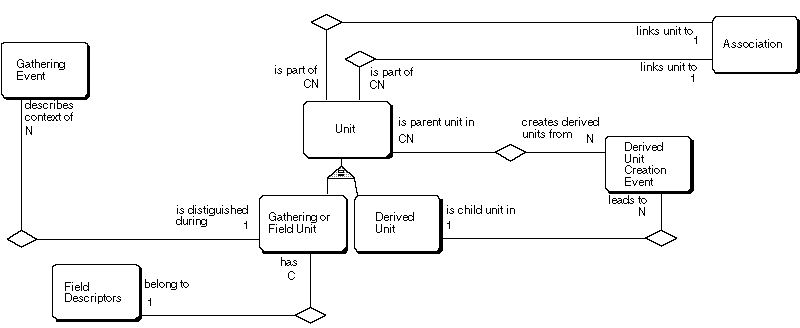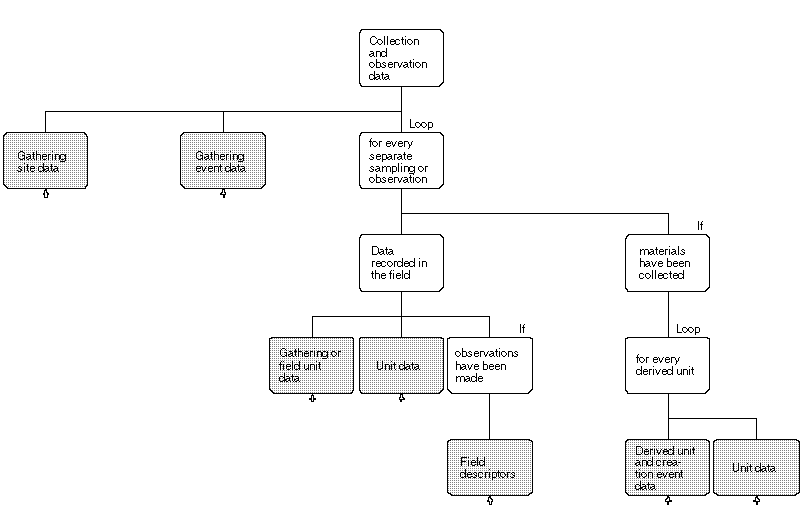

Diagram 4: Core ER-Model (Entities)
The concept of a Unit as a physical object in the field or in a collection is central to the CDEFD model. It includes organisms observed in the field or soil samples taken, herbarium specimens, microbial strains, or even pure substances in a natural products collection. Field data, taxonomic identifications, curatorial activities, collection management data as well as all kinds of descriptive data, are linked to units. Diagram 4 and Diagram 5 illustrate the backbone of the CDEFD collection model. All entities and data items mentioned here are later described in more detail.
The Gathering Event as an entity links the data on the collected items or observations with the information about the gathering and the description of the site of the collection or observation. The super entity Collection Event defined in the ASC model (ASC 1992) is roughly analogous to this construct. The structure of the gathering event and site information are detailed in Diagrams 6, 7 ,8 ,9 ,10.
The unit subtype entity Gathering or Field Unit is the central interface for all field data belonging to a particular object or observation. Every instance carries a specific identifier (e.g. a collection or sample number, see Diagram Diagram 11). The data are recorded while all collected materials are still united in the field. The delimitation of the gathering or field unit (i.e. which materials collected in a gathering event form a unit) depends on the collector's criteria and/or on the kind of organism (one or several taxa may be included).
The selection of Field Descriptors strongly depends on the objective of the sampling or observation. For example, ethnobotanists will use a field descriptor set which accentuates plant uses, a dendrologist will record more information about a tree than the usual botanical collector, for whom in turn recording the life form of a plant is a necessity. In inventory projects such as those carried out for floristic mapping, field descriptors may even be lacking, only a taxonomic identification and presence-absence data being recorded. Typically, data found here include features which cannot be observed or which are likely to change in the collected materials themselves, e.g. the height of a tree from which a herbarium specimen was taken, or many colour characteristics. Further information and an example for a field descriptor set is provided in Diagram 12 and Diagram 13.
The information described so far applies to both, observations on objects in the field and collections. In contrast, a Derived Unit represents a physical item in a specific collection. From the gathering or field unit, several derived units may be created, which in turn may again give rise to new derived units (e.g. separation of duplicate herbarium specimens, sampling of fungi from leaves in a botanical garden, propagation events in living collections, etc.). Merging of several units is also possible, e.g. for re-synthesized lichens, mating studies in fungi, or mixed seed samples. Administrative data such as accession coding, storage, transactions (loans etc.), are linked to the derived unit. The Derived Unit Creation Event is an entity containing all data describing the creation of derived units, such as date of event, curator or scientist responsible for the event, and applied method.
Defining an Association of units may be necessary because the data are so intimately related that they are usually cited together (e.g. a fungal parasite and the tree it grows on).

Diagram 5: Main components of biological collection and observation data